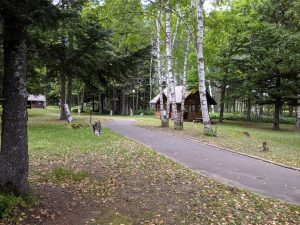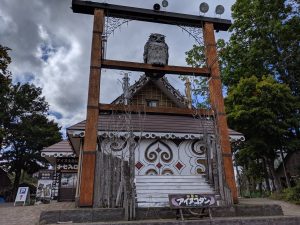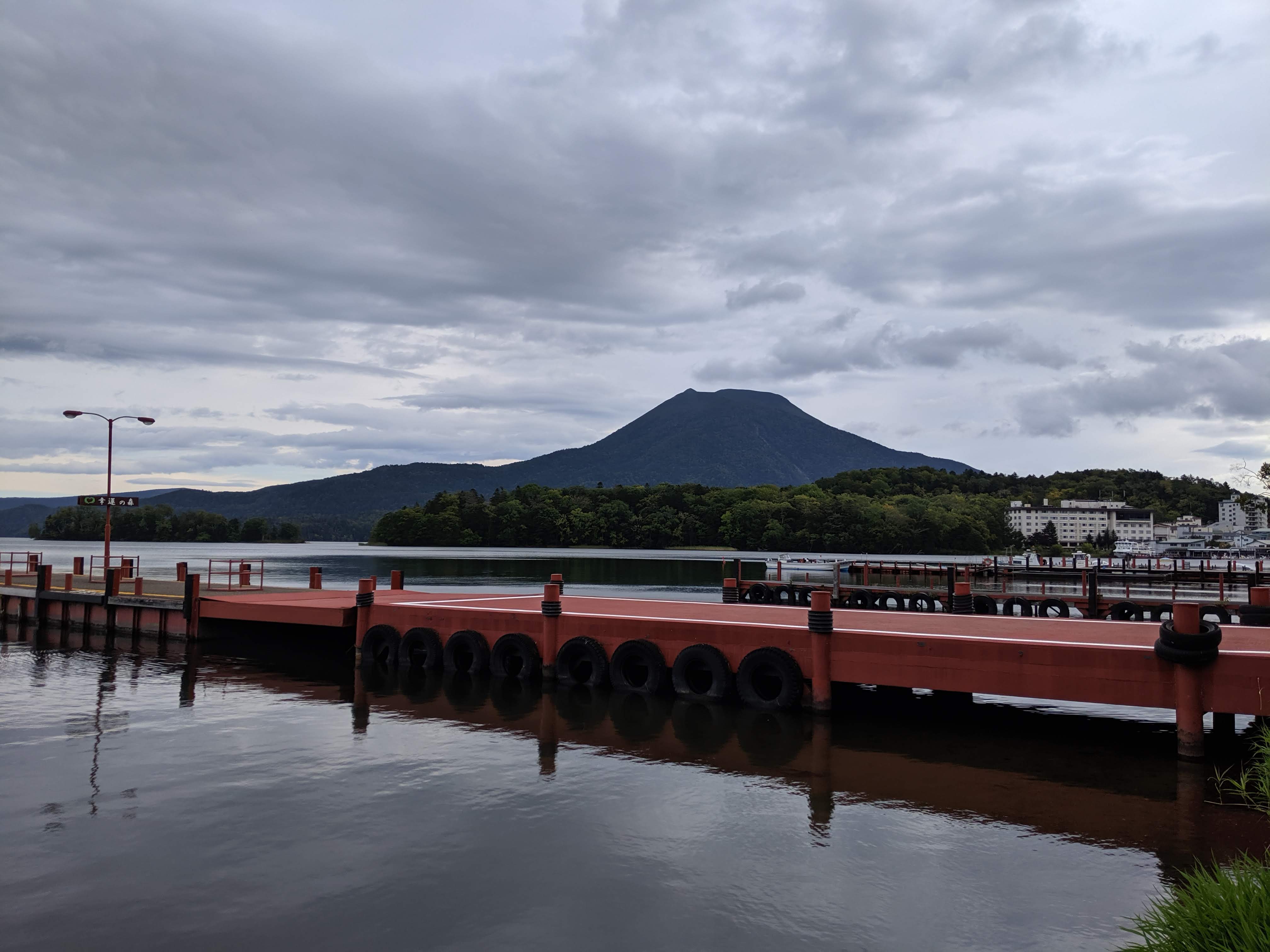This article originally featured in the May 2020 issue of Connect.
Krystin Pickering (Hokkaido)
‘Twas the season for welcome parties, and the Eastern HAJET welcome event just so happened to be in Akan, a place I had wanted to visit since I got here. Home to the Ainu Kotan, a village of the indigenous Ainu people of Hokkaido, Akan sits tucked away in a national park, and the town itself boasts beautiful views over its lake and nearby volcano. I had read about the Ainu during a day of pre-arrival Hokkaido research, and as a lover of cultures and languages, I hoped I could learn quite a bit by visiting. It seemed fitting, considering the Ainu have left their touch on the island, that I should do some investigating.
The itinerary said we were going to be staying at the campsite nestled in the trees and across from the lake. The campsite sat directly across the street from the Kotan, which meant we would be able to hear the music over the speakers from there. Camping sounded like a great idea, except I didn’t own a tent or a sleeping bag. I managed to swing a tent from the organizer of the event and decided I would just make a bed roll instead of buying a sleeping bag. A thin comforter, my patch blanket, and a pillow, and I could sleep in sweatpants and a hoodie. Surely that would be warm enough? (Spoiler alert: it wasn’t.) I hitched a ride with two other local JETs, and headed out at around 8:00 on Saturday morning, as we were coming from central Hokkaido, and this shindig was happening in eastern Hokkaido. Four and a half hours of drive time laid before us—not factoring in the stops for breakfast—so our gracious driver popped in some tunes and we headed off.

The drive over was almost as striking as the pictures of Akan itself. I was initially worried about keeping from boredom on the ride over, but being from a relatively flat area of Texas, the mountain ranges and dramatic river drop-offs took my breath away. I kept my face glued to the window like a child for most of the trip. Coming from our town, we had to pass through Furano and loop around the outside of Daisetsuzan National Park before we reached the edges of Akan National Park. Mount Asahidake was visible for most of the journey, towering over its neighbours and the endless farm plots. At least part of it was visible until we hit the forest of Akan National Park where we lost it to the birch trees. I wish I had taken pictures, but I couldn’t stop gawking out the window.
We arrived in Akancho at around 13:00, dropped off the car, and set up camp at Akankohan campground. Nestled in what I can only describe as a birch grove, we were greeted by the music of the wind rustling through the leaves. Tent secured, I got settled to the tune of the Ainu music playing from the Kotan. Once everyone was finished, we decided to check out the lake vistas and Mount Akan itself. It was a pleasant walk through town to reach the ferry boat docks, which turned about to be one of the best places to take pictures. Every shot looked like a postcard. It was the first volcano I had ever seen up close, and my inner child cheered upon recognition of the caldera at the top.
Nature itch scratched, we headed back up to explore the Kotan in greater detail. The first thing I noticed was how the recorded music filled the space and seemed to work with the sound of the wind through the trees rather than against it. The songs featured their famous single-stringed instrument, the mukkuri, and though we weren’t fortunate enough to catch a dance, I imagine it would be incredible. I’ve heard it said in jest that the Ainu must have invented club music, because the rhythmic plucking of the mukkuri resembles what I can only describe as rustic techno. A rather intimidating statute of an owl welcomed us into the square which was lined with shops. Each one boasted handcrafted items with Ainu patterns or animal motifs. Several sold rather impressive wood crafts, along with some smaller leather and metal-worked items. Were suitcase restrictions not a barrier, I found quite a few things that would have looked great in my future living room, but alas, those two 23 kilogram bags weren’t quite enough.
 While perusing a wall filled with fabrics printed with a pattern that I was told helped to ward off evil spirits, I spotted a flier for a place called “Between the Bread” on the stand. I leaned down to look, since after five and a half months in Japan the idea of a good sandwich was enticing to me, and I spotted the Holy Grail of items listed on the front—Lake Akan crawfish sandwich. Be still, my beating Cajun heart. We absolutely made the hike back down to the ferry docks to Between the Bread. Boy, it was absolutely worth the trip! The crawfish were wonderfully cooked, coated in a lightly spiced mayonnaise-based sauce, nestled on a bed of crisp lettuce, and all wrapped up in a buttery toasted bun. Hats off to the owners. I hope it’s there for years to come.
While perusing a wall filled with fabrics printed with a pattern that I was told helped to ward off evil spirits, I spotted a flier for a place called “Between the Bread” on the stand. I leaned down to look, since after five and a half months in Japan the idea of a good sandwich was enticing to me, and I spotted the Holy Grail of items listed on the front—Lake Akan crawfish sandwich. Be still, my beating Cajun heart. We absolutely made the hike back down to the ferry docks to Between the Bread. Boy, it was absolutely worth the trip! The crawfish were wonderfully cooked, coated in a lightly spiced mayonnaise-based sauce, nestled on a bed of crisp lettuce, and all wrapped up in a buttery toasted bun. Hats off to the owners. I hope it’s there for years to come.
Since no campout is complete without a cookout, the welcome crew had taken over the kitchens to serve up some chili to help keep us warm after sunset. Even in the warmer months, Hokkaido still managed to hit us with a chill most nights. My Singaporean counterpart and I quickly wrapped up in our blankets and scarves. Our driver was still wandering around in a T-shirt like a madman. The chill set in well once the chili was gone, and we made a break for the foot onsen on site. You know when you get in the shower cold, and the water feels almost scalding to just your toes? Yeah, that was what the onsen was like. Took me a good thirty minutes of just my heels floating in and letting the steam warm my toes before I could finally put my feet in. It was worth the wait though. How many ALTs can you fit in a small foot onsen? Apparently, 20, most of whom cracked open a biru and let the steam warm us up.
Morning came early, and though I normally detest the sun, I was happy to feel its warmth after a cold night. Definitely should have bought a sleeping bag. We broke camp and headed out toward home, but not before making a stop at a nearby natural hot spring. This particular onsen had been recommended to us by a kind local man at the foot onsen the previous night. We pulled into the parking lot of the Meakan Hot Spring, named for mountain behind it. It reeked of sulphur, which meant it had to be the real deal. And boy, it was. Volcanoes are hot, y’all. We weren’t in very long since the water was so toasty, but soaking down into a natural spring at the base of a volcano in the middle of a birch forest? Worth it.
Our trip to Akan unleashed an even greater curiosity for the Ainu people. They have left their fingerprint across the island, from their language in the names of towns, to holy sites dedicated to the kamuy (divine being), and to events and festivals. I hope to find ways to learn more and interact with the memory of the original inhabitants of Hokkaido. There are still so many Ainu sites for me to explore, but Akan was a great place to start.
‘Twas the season for welcome parties, and the Eastern HAJET welcome event just so happened to be in Akan, a place I had wanted to visit since I got here. Home to the Ainu Kotan, a village of the indigenous Ainu people of Hokkaido, Akan sits tucked away in a national park, and the town itself boasts beautiful views over its lake and nearby volcano. I had read about the Ainu during a day of pre-arrival Hokkaido research, and as a lover of cultures and languages, I hoped I could learn quite a bit by visiting. It seemed fitting, considering the Ainu have left their touch on the island, that I should do some investigating.
The itinerary said we were going to be staying at the campsite nestled in the trees and across from the lake. The campsite sat directly across the street from the Kotan, which meant we would be able to hear the music over the speakers from there. Camping sounded like a great idea, except I didn’t own a tent or a sleeping bag. I managed to swing a tent from the organizer of the event and decided I would just make a bed roll instead of buying a sleeping bag. A thin comforter, my patch blanket, and a pillow, and I could sleep in sweatpants and a hoodie. Surely that would be warm enough? (Spoiler alert: it wasn’t.) I hitched a ride with two other local JETs, and headed out at around 8:00 on Saturday morning, as we were coming from central Hokkaido, and this shindig was happening in eastern Hokkaido. Four and a half hours of drive time laid before us—not factoring in the stops for breakfast—so our gracious driver popped in some tunes and we headed off.
 The drive over was almost as striking as the pictures of Akan itself. I was initially worried about keeping from boredom on the ride over, but being from a relatively flat area of Texas, the mountain ranges and dramatic river drop-offs took my breath away. I kept my face glued to the window like a child for most of the trip. Coming from our town, we had to pass through Furano and loop around the outside of Daisetsuzan National Park before we reached the edges of Akan National Park. Mount Asahidake was visible for most of the journey, towering over its neighbours and the endless farm plots. At least part of it was visible until we hit the forest of Akan National Park where we lost it to the birch trees. I wish I had taken pictures, but I couldn’t stop gawking out the window.
The drive over was almost as striking as the pictures of Akan itself. I was initially worried about keeping from boredom on the ride over, but being from a relatively flat area of Texas, the mountain ranges and dramatic river drop-offs took my breath away. I kept my face glued to the window like a child for most of the trip. Coming from our town, we had to pass through Furano and loop around the outside of Daisetsuzan National Park before we reached the edges of Akan National Park. Mount Asahidake was visible for most of the journey, towering over its neighbours and the endless farm plots. At least part of it was visible until we hit the forest of Akan National Park where we lost it to the birch trees. I wish I had taken pictures, but I couldn’t stop gawking out the window.
We arrived in Akancho at around 13:00, dropped off the car, and set up camp at Akankohan campground. Nestled in what I can only describe as a birch grove, we were greeted by the music of the wind rustling through the leaves. Tent secured, I got settled to the tune of the Ainu music playing from the Kotan. Once everyone was finished, we decided to check out the lake vistas and Mount Akan itself. It was a pleasant walk through town to reach the ferry boat docks, which turned about to be one of the best places to take pictures. Every shot looked like a postcard. It was the first volcano I had ever seen up close, and my inner child cheered upon recognition of the caldera at the top.
Nature itch scratched, we headed back up to explore the Kotan in greater detail. The first thing I noticed was how the recorded music filled the space and seemed to work with the sound of the wind through the trees rather than against it. The songs featured their famous single-stringed instrument, the mukkuri, and though we weren’t fortunate enough to catch a dance, I imagine it would be incredible. I’ve heard it said in jest that the Ainu must have invented club music, because the rhythmic plucking of the mukkuri resembles what I can only describe as rustic techno. A rather intimidating statute of an owl welcomed us into the square which was lined with shops. Each one boasted handcrafted items with Ainu patterns or animal motifs. Several sold rather impressive wood crafts, along with some smaller leather and metal-worked items. Were suitcase restrictions not a barrier, I found quite a few things that would have looked great in my future living room, but alas, those two 23 kilogram bags weren’t quite enough.
While perusing a wall filled with fabrics printed with a pattern that I was told helped to ward off evil spirits, I spotted a flier for a place called “Between the Bread” on the stand. I leaned down to look, since after five and a half months in Japan the idea of a good sandwich was enticing to me, and I spotted the Holy Grail of items listed on the front—Lake Akan crawfish sandwich. Be still, my beating Cajun heart. We absolutely made the hike back down to the ferry docks to Between the Bread. Boy, it was absolutely worth the trip! The crawfish were wonderfully cooked, coated in a lightly spiced mayonnaise-based sauce, nestled on a bed of crisp lettuce, and all wrapped up in a buttery toasted bun. Hats off to the owners. I hope it’s there for years to come.
Since no campout is complete without a cookout, the welcome crew had taken over the kitchens to serve up some chili to help keep us warm after sunset. Even in the warmer months, Hokkaido still managed to hit us with a chill most nights. My Singaporean counterpart and I quickly wrapped up in our blankets and scarves. Our driver was still wandering around in a T-shirt like a madman. The chill set in well once the chili was gone, and we made a break for the foot onsen on site. You know when you get in the shower cold, and the water feels almost scalding to just your toes? Yeah, that was what the onsen was like. Took me a good thirty minutes of just my heels floating in and letting the steam warm my toes before I could finally put my feet in. It was worth the wait though. How many ALTs can you fit in a small foot onsen? Apparently, 20, most of whom cracked open a biru and let the steam warm us up.
Morning came early, and though I normally detest the sun, I was happy to feel its warmth after a cold night. Definitely should have bought a sleeping bag. We broke camp and headed out toward home, but not before making a stop at a nearby natural hot spring. This particular onsen had been recommended to us by a kind local man at the foot onsen the previous night. We pulled into the parking lot of the Meakan Hot Spring, named for mountain behind it. It reeked of sulphur, which meant it had to be the real deal. And boy, it was. Volcanoes are hot, y’all. We weren’t in very long since the water was so toasty, but soaking down into a natural spring at the base of a volcano in the middle of a birch forest? Worth it.
Our trip to Akan unleashed an even greater curiosity for the Ainu people. They have left their fingerprint across the island, from their language in the names of towns, to holy sites dedicated to the kamuy (divine being), and to events and festivals. I hope to find ways to learn more and interact with the memory of the original inhabitants of Hokkaido. There are still so many Ainu sites for me to explore, but Akan was a great place to start.
Cover image: Mt. Akan over Lake Akan
Krystin is entering her second year as an ALT in Hokkaido, stationed in Takikawa City. Originally from a small town near Houston, Texas, she has enjoyed the frigid weather and craggy landscapes of Hokkaido. A first-generation graduate, she majored in biology and minored in French, and she decided to take Japanese during her final year. She now wishes she had taken better note in Japanese class.




